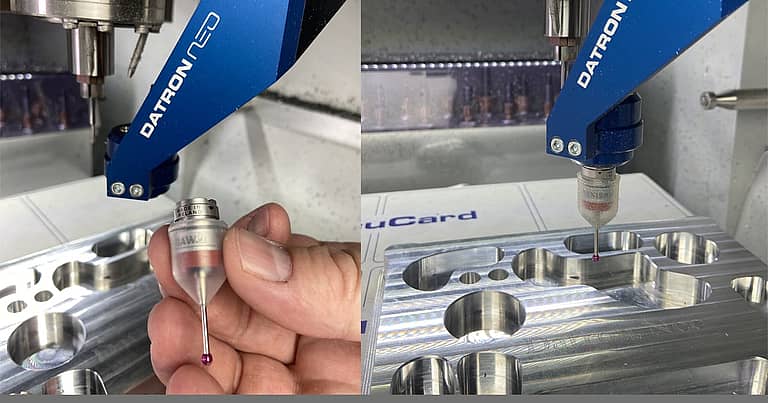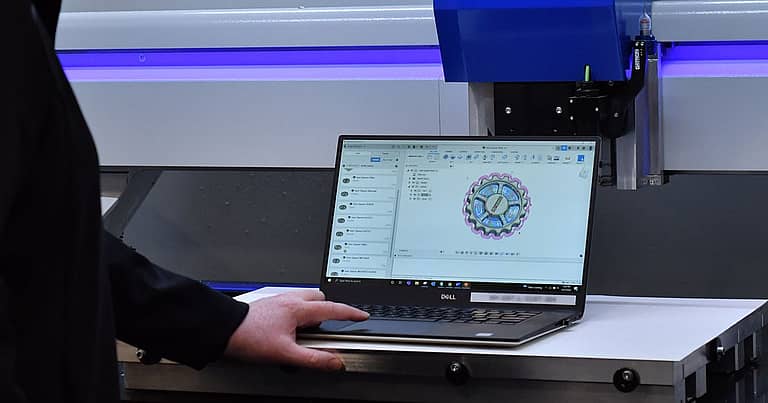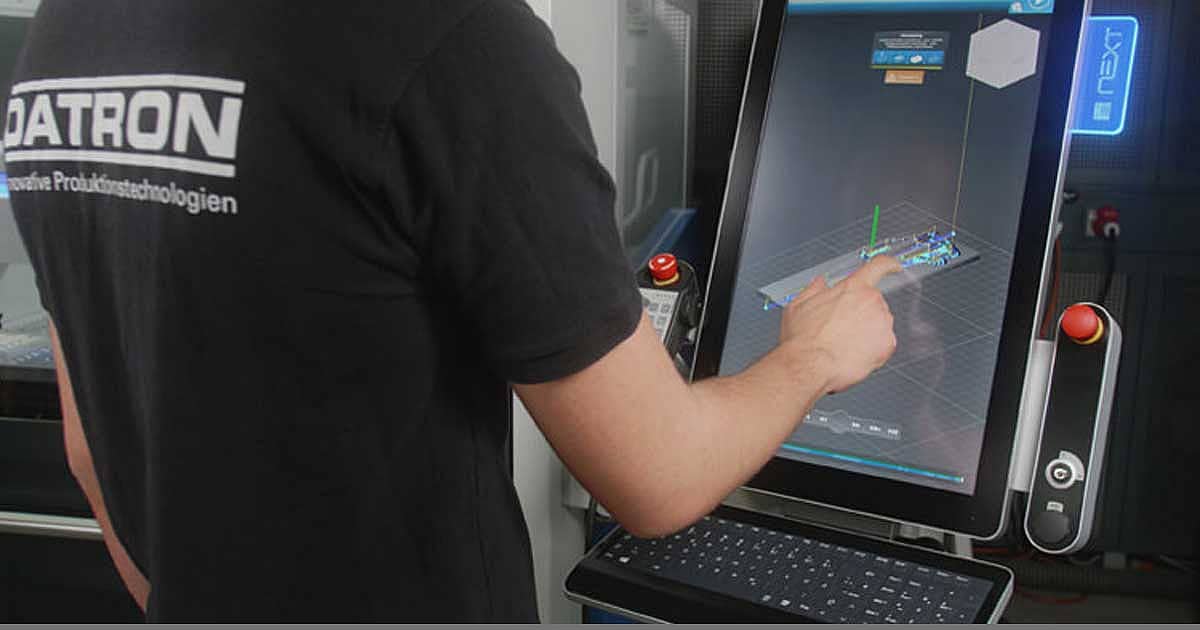
When tasked with bringing prototyping in-house or building your own prototyping lab, you might find there is an overwhelming wealth of information to evaluate.
From capabilities to costs, space requirements, and concerns over noise, vibration, waste, and energy efficiency, the ability to isolate and act on your operation’s specific needs can be complicated.
This is especially true as manufacturing evolves and new processes like generative design take center stage, offering even more complexities to consider.
Modern Machine Shop recently reported that,
“New developments in generative design can help companies make better decisions about part design by including manufacturability as a key value. CNC milling, for example, not an additive process, might come up as the better choice for making a complex part.”
Let’s learn more about these cutting-edge developments and how generative design can work in perfect harmony with CNC milling in your prototype lab.
The Genesis of Generative Design
Generative design is disrupting the way manufacturing has been done from both a practical and philosophical standpoint – with a perspective rooted in an appreciation for the natural world and evolution, specifically.
“Evolution has, over billions of years, perfected the animal and plant species that populate the planet, discarding less than optimal designs in favor of those that can survive and thrive,” writes Rani Richardson for Industry Week.
The Genesis of Generative Design
Generative design is disrupting the way manufacturing has been done from both a practical and philosophical standpoint – with a perspective rooted in an appreciation for the natural world and evolution, specifically.
“Evolution has, over billions of years, perfected the animal and plant species that populate the planet, discarding less than optimal designs in favor of those that can survive and thrive,” writes Rani Richardson for Industry Week.
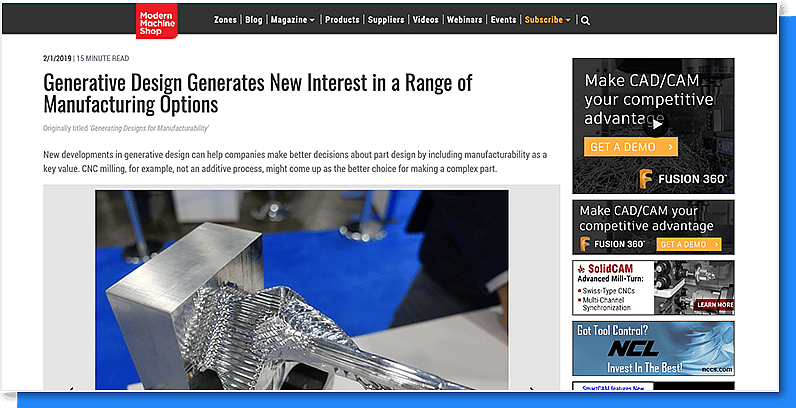
In pursuit of a similarly perfected process, Richardson asks, “What if evolutionary design could be mimicked using science-based methods? And what if that process could be sped up to be completed in minutes and seconds instead of years or eons?”
Enter generative design, “which uses machine learning to circumvent the evolutionary approach and cut right to the optimal form.”
By innovating the process of bringing prototype to production:
“Generative design is promising to revolutionize the way we design—by using algorithms inspired by the way in which bones grow in animals—to place material where it needs to be and removing it from where it doesn’t. Generative design is promising to shatter the old philosophy of form follows function and replace it with a new philosophy of form follows force.”
This new philosophy is gaining traction, thanks to Artificial Intelligence and a re-imagined design process. At its core, the design process “is typically a series of reductive refinements, looking at the design brief in a wider scope and narrowing it down until the best possible solution is found.”
The integration of Artificial Intelligence into generative design has shifted how prototyping can be accomplished – allowing for more diverse outcomes than could have ever been realized before.
According to Industry Week:
Generative design is becoming a big part of the technology shifts known as the Factory of the Future and Industry 4.0. More and more companies are seeing the benefits associated with automation and data exchange in manufacturing technologies, and subsequently seeing the same benefits and principles for design and simulation in generative design.
Taking this undeniable momentum into account, where does generative design fit into your manufacturing model?
What Does Generative Design Mean to Manufacturers?
Modern manufacturing is consistently challenged by consumer demand for better products that can be delivered to the market faster than ever before. This need for speed, combined with the relentless pursuit of ever better products, can prove taxing to the manufacturing process.
Enter the advantage of Artificial Intelligence inherent in generative design: “But, like many modern applications of artificial intelligence, the basic notion is this: if you pool enough computing horsepower, your network is capable of completing many iterations of very complex tasks very quickly.”
In order to stay competitive and protect their bottom line, more and more manufacturers are increasingly relying on generative design as a key strategy that allows “engineers and designers alike to approach design problems in more innovative and efficient ways. Ultimately, this shortens the design and prototyping process and speeds up the time it takes for innovative products to hit the market.”
Shorter production times, increased efficiency, and enhanced innovation are all moving targets tracked by manufacturers. Generative design offers the ability to take aim and nail the bull’s eye on each one.
What Does Generative Design Actually Generate?
A better question might be, what does it not generate?
Generative design has encouraging implications for a variety of verticals including aeronautical, automotive, and defense.
While the manufacturing industry projects additional applications for this enhanced design thinking, “There are numerous examples of where these tools are already being used today, from house-hold items such as chairs, to the industrial design of car chassis and aeroplane partitions.”
For the aerospace and automotive industries, “generative design helps engineers to achieve objectives such as minimizing part weight, maximizing stiffness, reducing cost and optimizing material usage. The use of generative design can reduce part weight from up to 30% using traditional manufacturing to 70% using additive manufacturing.”
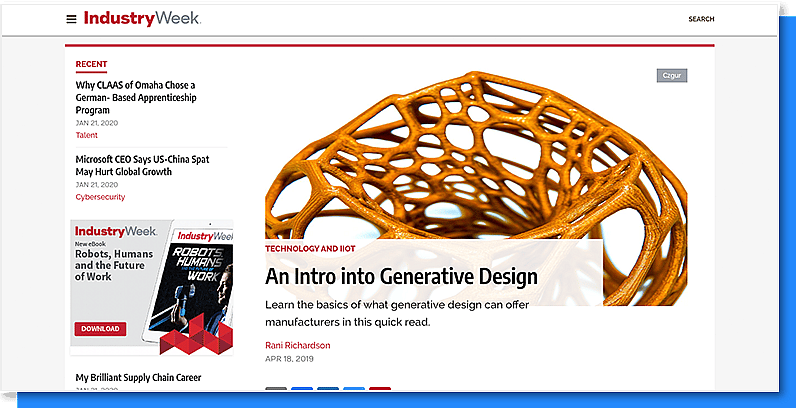
From a consumer goods-standpoint, we are already seeing a range of highly recognizable products made available on the market by generative design. Good news if your prototyping lab caters to clients who make these products.
What kinds of consumer products, specifically?
“Well, the consumer products created with generative design are already hitting our shelves in the form of Adidas sneakers and Vitamix blender nozzles, and we should expect more products to follow in the form of sporting goods, cell phone cases and home appliances.”
But that’s really the tip of the iceberg: “There are virtually no limits to what generative design can create. With its basis in the designs of nature, generative design is almost a representation of design coming full circle.”
What Does Generative Design Promise for In-house Prototyping?
Generative design presents more possibilities for prototyping than traditional processes have ever been able to provide. To start, generative design gives you the power to increase both the quantity and quality of prototypes you produce, based on design specifications and product needs.
The Potential for Better Prototypes
Rather than relying on a single solution or prototype, manufacturers can now reap the benefits of greater design precision for stronger client solutions:
Generative design creates thousands of possible solutions for a product – based on criteria and goals set by the designer – and produces geometries and forms that would normally take a human days, if not months, to develop manually… This process ensures the designer or engineer is picking the one design that meets the most important goals of their specific design.

When it comes to strategic, scientifically-backed solutions, generative design offers more compelling options and, “These options often include unconventional geometries that a human designer would likely never come up with – geometries that perform better than their more conventional counterparts.”
From an operations perspective, better prototypes plus better performance equals better products. For a designer, generative design is the integration of artificial intelligence into their tool set; thus, allowing for new methods to solve the toughest of design dilemmas, and more importantly, expedite a product to market.
The Human Factor Meets Generative Design
Of course, practically any mention of Artificial Intelligence in manufacturing or other industries is automatically met with concern that robots are replacing humans and that processes like generative design will soon eliminate the need for a human workforce.
Granted, generative design is projected to transform the manufacturing landscape over the course of the next ten years.
According to Bryce Heventhal, Technical Marketing Manager for Autodesk, Inc,
“It’s a process that enables human engineers using computer-aided design (CAD) to define an engineering problem, which is then solved over and over again by an adaptive artificial intelligence program, yielding different results each time”.
Note the critical component of that sentence: human engineers.
In fact, “There’s one thing that Heventhal wants to stress about generative design—it is not intended to replace human workers. Rather, he says artificial intelligence is a valuable mechanism for expanding, by orders of magnitude, the capabilities of engineers and designers to test new designs and incorporate them into the products they build.”
Simply put, “They’re still making the decisions,” Heventhal says. “We’re just giving them better tools to make those decisions. It’s not going to replace jobs, it’s going to augment jobs.”
From a human evolution standpoint, this is like tracing the development of early to modern man and the use of rudimentary tools and eventual advanced applications. Generative design is just the latest chapter of mankind leveraging technology:
“Design thinking isn’t going away, it’s evolving to take advantage of modern tools. In the same way a carpenter uses a power drill instead of a hand drill, the product designers and engineers of tomorrow will slowly abandon manual processes.”
Balancing Complexity with Manufacturability
One of the concerns that comes from generatively designed parts is their level of complexity to fabricate. It’s not uncommon to hear generative design parts described as “alien,” “organic,” or “bizarre.”
Fortunately, the aesthetics comes in a distant second to functionality; however, it does introduce a level of complications for the manufacturing process – with multitudes of sculpted surfaces, the process of creating a generative design part can be lengthy, and inefficient.

Luckily, the birth of generative design coincided nicely with advancements in manufacturing processes. Most notably, advancements in additive manufacturing over the past decade have accelerated the capabilities of 3D printers, while simultaneously reducing their cost. However, there are limitations – most notably when high precision is needed. While this continues to improve in the realm of additive manufacturing, it is currently out of reach for many prototype labs due to high up-front and up-keep costs.
In the subtractive manufacturing world, 5-axis CNC machining has become more widespread, with a greater number of brands offering capable equipment and more software than ever to help create the complex toolpaths necessary to create a generative design part.
Yet, as with anything, there are drawbacks.
Due to their demanding controls, 5-axis machines require a higher level of skill from the operator and the programmer. In addition, to protect the investment in a 5-axis mill, a second set of software is often recommended to simulate the toolpath to inspect for collisions.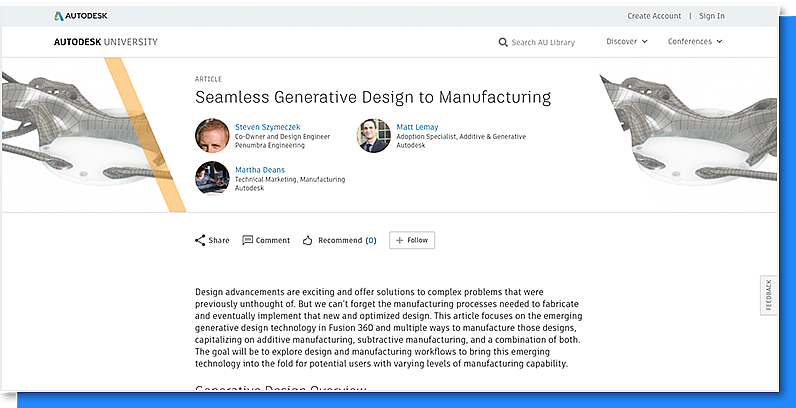
On top of that, 5-axis machines can become quite expensive. This is inherent in their design – whenever an axis is introduced to a milling machine, more work area is sacrificed – subsequently, even 5-axis machines with small work envelopes can be quite large. The situation isn’t ideal then when a large generative design part needs to be milled – it is no exaggeration to state that the necessary machine can cost upwards of 7 figures before tooling costs. Even the tooling is specialized in this case to be able to reach the deep, elaborate features in the generative designed part.
While enough money can solve these problems, most prototype labs would rather make parts with the tools they have, and most of them have 3-axis mills, not 5. Fortunately, the team at Autodesk, manufacturers of Fusion 360, were paying attention to this conundrum.
“Manufacturing is a consideration that’s often considered late in the design process or left as something for the manufacturing specialist to figure out after the fact. Generative design takes manufacturing methods into consideration from the start to help ensure the result is something that can be made.”
With manufacturing constraints, users can define exactly how they will produce their end product – be it with 3D printing, or the exact method of CNC machining they have on hand (2.5, 3, 4, or 5-axis CNC milling). By introducing this data at the onset, the program algorithms can create shapes that work flawlessly with their machine configuration. With the addition of this capability, Autodesk has found a way to make generative design approachable and practical for the widest possible audience.
Be a Part of the Evolution
Ultimately, generative design is an exciting development for manufacturers, not to mention a variety of verticals, and consumers, as: “AI and generative design tools’ capacity to drive innovation and efficiencies will see their adoption catapult across industries. They will become the new collaborators in the design process, enhancing the roles of the designer and engineer and creating products like we’ve never seen before.”





